MAKITA BU01 Cordless Blower
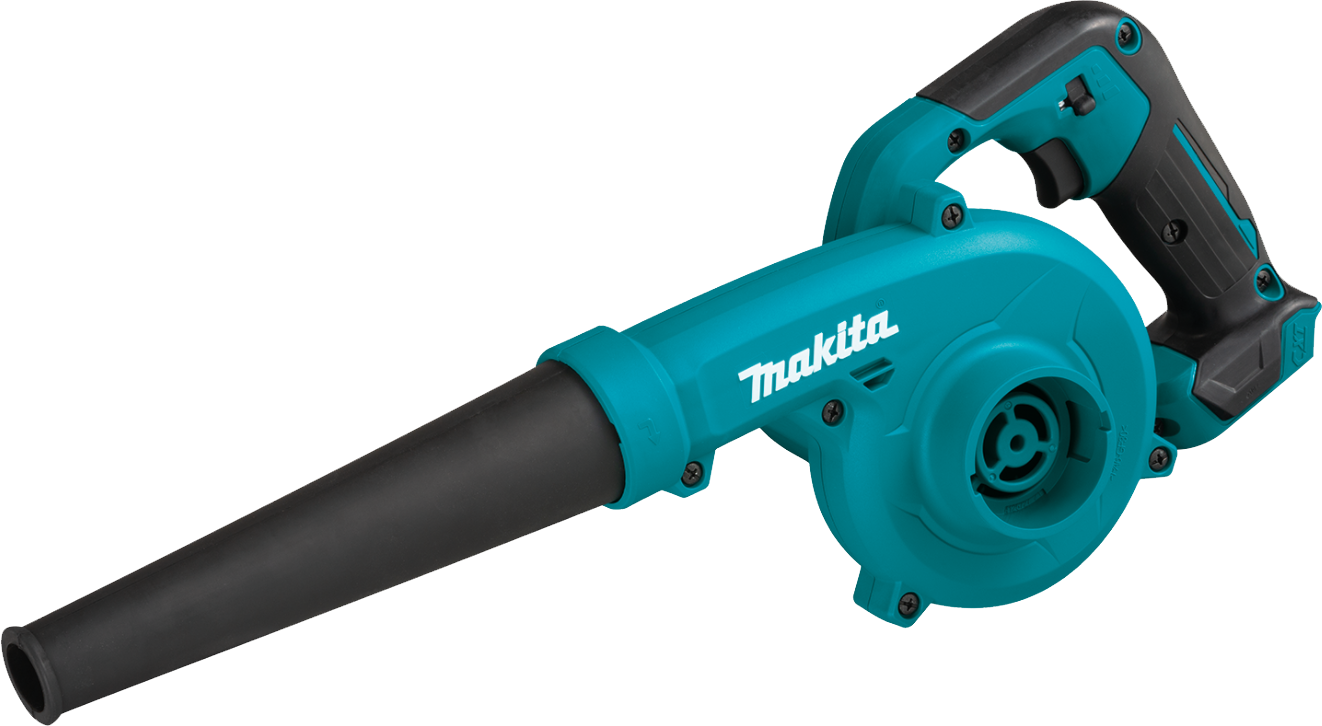

SPECIFICATIONS
|
Model: |
BU01 |
BU02 |
|
| Capacities | Air volume *1 | 0 – 2.6 m3/min (0 – 92 cu.ft./min) | |
| Air speed (average) | 0 – 62 m/s (0 – 139 MPH) *2 | 0 – 45 m/s (0 – 101 MPH) *3 | |
| Air speed (max.) | 0 – 75 m/s (0 – 168 MPH) *2 | 0 – 56 m/s (0 – 125 MPH) *3 | |
| Overall length | 508 mm (20″) *4 | 852 mm (33-1/2″) *5 | |
| Rated voltage | D.C. 10.8 V – 12 V max | ||
| Net weight | With nozzle | 1.4 – 1.9 kg (3.1 – 4.2 lbs) | – |
| With garden nozzle | – | 1.4 – 1.9 kg (3.1 – 4.2 lbs) |
- Without nozzles.
- With nozzle.
- With garden nozzle.
- With nozzle and battery cartridge (BL1041B), and without dust bag.
- With garden nozzle and battery cartridge (BL1041B), and without dust bag.
- Due to our continuing program of research and development, the specifications herein are subject to change without notice.
- Specifications may differ from country to country.
- The weight may differ depending on the attachment(s), including the battery cartridge. The lightest and heaviest combination, according to EPTA-Procedure 01/2014, are shown in the table.
Applicable Battery Cartridge and Charger
| Battery Cartridge |
BL1016 / BL1021B / BL1041B |
| Charger |
DC10SB / DC10WD / DC18RE |
Some of the battery cartridges and chargers listed above may not be available depending on your region of residence.
WARNING: Only use the battery cartridges and chargers listed above. Use of any other battery cartridges and chargers may cause injury and/or fire.
SAFETY WARNINGS
General Power Tool Safety Warnings
Save all warnings and instructions for future reference.The term “power tool” in the warnings refers to your mains-operated (corded) power tool or battery-operated (cordless) power tool.
Work Area Safety
- Keep work area clean and well lit. Cluttered or dark areas invite accidents.
- Do not operate power tools in explosive atmospheres, such as in the presence of flammable liquids, gases or dust. Power tools create sparks which may ignite the dust or fumes.
- Keep children and bystanders away while operating a power tool. Distractions can cause you to lose control.
Electrical Safety
- Power tool plugs must match the outlet. Never modify the plug in any way. Do not use any adapter plugs with earthed (grounded) power tools. Unmodified plugs and matching outlets will reduce risk of electric shock.
- Avoid body contact with earthed or grounded surfaces, such as pipes, radiators, ranges and refrigerators. There is an increased risk of electric shock if your body is earthed or grounded.
- Do not expose power tools to rain or wet conditions. Water entering a power tool will increase the risk of electric shock.
- Do not abuse the cord. Never use the cord for carrying, pulling or unplugging the power tool. Keep cord away from heat, oil, sharp edges or moving parts. Damaged or entangled cords increase the risk of electric shock.
- When operating a power tool outdoors, use an extension cord suitable for outdoor use. Use of a cord suitable for outdoor use reduces the risk of electric shock.
- If operating a power tool in a damp location is unavoidable, use a ground fault circuit interrupter (GFCI) protected supply. Use of a GFCI reduces the risk of electric shock.
- Power tools can produce electromagnetic fields (EMF) that are not harmful to the user. However, users of pacemakers and other similar medical devices should contact the maker of their device and/or doctor for advice before operating this power tool.
Personal Safety
- Stay alert, watch what you are doing and use common sense when operating a power tool. Do not use a power tool while you are tired or under the influence of drugs, alcohol or medication. A moment of inattention while operating power tools may result in serious personal injury.
- Use personal protective equipment. Always wear eye protection. Protective equipment such as dust mask, non-skid safety shoes, hard hat, or hearing protection used for appropriate conditions will reduce personal injuries.
- Prevent unintentional starting. Ensure the switch is in the off-position before connecting to power source and/or battery pack, picking up or carrying the tool. Carrying power tools with your finger on the switch or energizing power tools that have the switch on invites accidents.
- Remove any adjusting key or wrench before turning the power tool on. A wrench or a key left attached to a rotating part of the power tool may result in personal injury.
- Do not overreach. Keep proper footing and balance at all times. This enables better control of the power tool in unexpected situations.
- Dress properly. Do not wear loose clothing or jewelry. Keep your hair, clothing and gloves away from moving parts. Loose clothes, jewelry or long hair can be caught in moving parts.
- If devices are provided for the connection of dust extraction and collection facilities, ensure these are connected and properly used. Use of dust collection can reduce dust-related hazards.
- Do not let familiarity gained from frequent use of tools allow you to become complacent and ignore tool safety principles. A careless action can cause severe injury within a fraction of a second.
- Always wear protective goggles to protect your eyes from injury when using power tools. The goggles must comply with ANSI Z87.1 in the USA. It is an employer’s responsibility to enforce the use of appropriate safety protective equipment by the tool operators and by other persons in the immediate working area.
Power Tool Use and Care
- Do not force the power tool. Use the correct power tool for your application. The correct power tool will do the job better and safer at the rate for which it was designed.
- Do not use the power tool if the switch does not turn it on and off. Any power tool that cannot be controlled with the switch is dangerous and must be repaired.
- Disconnect the plug from the power source and/or remove the battery pack, if detachable, from the power tool before making any adjustments, changing accessories, or storing power tools. Such preventive safety measures reduce the risk of starting the power tool accidentally.
- Store idle power tools out of the reach of children and do not allow persons unfamiliar with the power tool or these instructions to operate the power tool. Power tools are dangerous in the hands of untrained users.
- Maintain power tools and accessories. Check for misalignment or binding of moving parts, breakage of parts and any other condition that may affect the power tool’s operation. If dam-aged, have the power tool repaired before use. Many accidents are caused by poorly maintained power tools.
- Keep cutting tools sharp and clean. Properly maintained cutting tools with sharp cutting edges are less likely to bind and are easier to control.
- Use the power tool, accessories and tool bits etc. in accordance with these instructions, taking into account the working conditions and the work to be performed. Use of the power tool for operations different from those intended could result in a hazardous situation.
- Keep handles and grasping surfaces dry, clean and free from oil and grease. Slippery handles and grasping surfaces do not allow for safe handling and control of the tool in unexpected situations.
- When using the tool, do not wear cloth work gloves which may be entangled. The entanglement of cloth work gloves in the moving parts may result in personal injury.
Battery Tool Use and Care
- Recharge only with the charger specified by the manufacturer. A charger that is suitable for one type of battery pack may create a risk of fire when used with another battery pack.
- Use power tools only with specifically designated battery packs. Use of any other battery packs may create a risk of injury and fire.
- When battery pack is not in use, keep it away from other metal objects, like paper clips, coins, keys, nails, screws or other small metal objects, that can make a connection from one terminal to another. Shorting the battery terminals together may cause burns or a fire.
- Under abusive conditions, liquid may be ejected from the battery; avoid contact. If con-tact accidentally occurs, flush with water. If liquid contacts eyes, additionally seek medical help. Liquid ejected from the battery may cause irritation or burns.
- Do not use a battery pack or tool that is dam-aged or modified. Damaged or modified batteries may exhibit unpredictable behavior resulting in fire, explosion or risk of injury.
- Do not expose a battery pack or tool to fire or excessive temperature. Exposure to fire or temperature above 130 °C may cause explosion.
- Follow all charging instructions and do not charge the battery pack or tool outside the temperature range specified in the instructions. Charging improperly or at temperatures outside the specified range may damage the battery and increase the risk of fire.
Service
- Have your power tool serviced by a qualified repair person using only identical replacement parts. This will ensure that the safety of the power tool is maintained.
- Never service damaged battery packs. Service of battery packs should only be performed by the manufacturer or authorized service providers.
- Follow instruction for lubricating and changing accessories.
- Do not modify or attempt to repair the appliance or the battery pack except as indicated in the instructions for use and care.
IMPORTANT SAFETY INSTRUCTIONS
When using an electrical appliance, basic precautions should always be followed, including the following:READ ALL INSTRUCTIONS BEFORE USING THIS APPLIANCE. WARNING – To reduce the risk of fire, electric shock, or injury:
- Do not leave appliance when battery fitted. Remove battery from appliance when not in use and before servicing.
- Do not expose to rain. Store indoors.
- Do not allow to be used as a toy. Close attention is necessary when used by or near children.
- Use only as described in this manual. Use only manufacturer’s recommended attachments.
- Do not use with damaged battery. If appliance is not working as it should, has been dropped, damaged, left outdoors, or dropped into water, return it to a service center.
- Do not put any object into openings. Do not use with any opening blocked; keep free of dust, lint, hair, and anything that may reduce air flow.
- Keep hair, loose clothing, fingers, and all parts of body away from openings and moving parts.
- Use extra care when cleaning on stairs.
- Use only the charger supplied by the manufacturer to recharge.
- Do not use to pick up flammable or combustible liquids, such as gasoline, or use in areas where they may be present.
- Do not pick up anything that is burning or smoking, such as cigarettes, matches, or hot ashes.
- Do not use without dust bag in place when collecting dust.
SAVE THESE INSTRUCTIONSThis appliance is intended for household use.
Cordless Blower Safety Instructions
Preparation
- Always wear substantial footwear and long trousers while operating the machine.
- Do not wear loose clothing or jewelry that can be drawn into the air inlet. Keep long hair away from the air inlets.
- Always use protective goggles, a cap and mask when using the machine. Ordinary eye or sun glasses are NOT safety glasses.
- To prevent dust irritation the wearing of a face mask is recommended.
- While operating the machine, always wear non-slip and protective footwear. Non-skid, closed-toed safety boots and shoes will reduce the risk of injury.
Operation
- Never operate the machine while people, especially children, or pets are nearby.
- Switch off the machine and remove the battery cartridge and make sure that all moving parts have come to a complete stop
- whenever you leave the machine.
- before clearing blockages.
- before checking, cleaning or working on the machine.
- if the machine starts to vibrate abnormally.
- whenever you convert the machine from blower to vacuum, and vice versa.
- Operate the machine only in daylight or in good artificial light.
- Do not overreach and keep proper balance and footing at all times.
- Never blow debris in the direction of bystanders.
- Operate the machine in a recommended position and on a firm surface.
- Do not operate the machine at high places.
- Never point the nozzle at anyone in the vicinity when using the machine.
- Never block suction inlet and/or blower outlet.
- Be careful not to block suction inlet or blower outlet with dust or dirt when operating in dusty area.
- Do not use nozzles other than the nozzles provided by Makita.
- Do not use the blower to inflate balls, rubber boat or the similar.
- Do not operate the machine near open window, etc.
- Operating the machine only at reasonable hours is recommended – not early in the morning or late at night when people might be disturbed.
- Using rakes and brooms to loosen debris before blowing is recommended.
- If the machine strikes any foreign objects or should start making any unusual noise or vibration, immediately switch off the machine to stop it. Remove the battery cartridge from the machine and inspect the machine for damage before restarting and operating the machine. If the machine is damaged, ask Makita Authorized Service Centers for repair.
- Do not insert fingers or other objects into suction inlet or blower outlet.
- Prevent unintentional starting. Ensure the switch is in the off-position before inserting battery cartridge, picking up or carrying the machine. Carrying the machine with your fin-ger on the switch or energizing the machine that has the switch on invites accidents.
- Never blow or vacuum dangerous materials, such as nails, fragments of glass, or blades.
- Do not operate the machine near flammable materials.
- Avoid operating the machine for a long time in low temperature environment.
- Always use the dust bag when collecting dust, chips and the like.
- Do not collect still smoldering cigarette ashes, freshly cut metals shavings, screws, nails and the like.
Maintenance and Storage
- Keep all nuts, bolts and screws tight to be sure the machine is in safe working condition.
- If the parts are worn or damaged, replace them with parts provided by Makita.
- Store the machine in a dry place out of the reach of children.
- When you stop the machine for inspection, servicing, storage, or changing accessory, switch off the machine and make sure that all moving parts come to a complete stop, and remove the battery cartridge. Cool down the machine before making any work on the machine. Maintain the machine with care and keep it clean.
- Always cool down the machine before storing.
- When you lift the machine, be sure to bend your knees and be careful not to hurt your back.
Battery Tool Use and Care
- Prevent unintentional starting. Ensure the switch is in the off-position before connecting to battery pack, picking up or carrying the machine. Carrying the machine with your finger on the switch or energizing machine that have the switch on invites accidents.
- Disconnect the battery pack from the machine before making any adjustments, changing accessories, or storing machine. Such preventive safety measures reduce the risk of starting the machine accidentally.
- Recharge only with the charger specified by the manufacturer. A charger that is suitable for one type of battery pack may create a risk of fire when used with another battery pack.
- Use machines only with specifically designated battery packs. Use of any other battery packs may create a risk of injury and fire.
- When battery pack is not in use, keep it away from other metal objects, like paper clips, coins, keys, nails, screws or other small metal objects, that can make a connection from one terminal to another. Shorting the battery terminals together may cause burns or a fire.
- Under abusive conditions, liquid may be ejected from the battery; avoid contact. If con-tact accidentally occurs, flush with water. If liquid contacts eyes, seek medical help. Liquid ejected from the battery may cause irritation or burns.
- Do not use a battery pack or machine that is damaged or modified. Damaged or modified batteries may exhibit unpredictable behavior resulting in fire, explosion or risk of injury.
- Do not expose a battery pack or machine to fire or excessive temperature. Exposure to fire or temperature above 130°C (265°F) may cause explosion.
- Follow all charging instructions and do not charge the battery pack or machine outside of the temperature range specified in the instructions. Charging improperly or at temperatures outside of the specified range may damage the battery and increase the risk of fire.
- Have servicing performed by a qualified repair person using only identical replacement parts. This will ensure that the safety of the product is maintained.
- Do not modify or attempt to repair the machine or the battery pack except as indicated in the instructions for use and care.
Electrical and Battery Safety
- Do not dispose of the battery(ies) in a fire. The cell may explode. Check with local codes for possible special disposal instructions.
- Do not open or mutilate the battery(ies). Released electrolyte is corrosive and may cause damage to the eyes or skin. It may be toxic if swallowed.
- Do not charge battery in rain, or in wet locations.
- Do not charge the battery outdoors.
- Do not handle charger, including charger plug, and charger terminals with wet hands.
- Avoid dangerous environment. Don’t use the tool in dump or wet locations or expose it to rain. Water entering the tool will increase the risk of electric shock.
Service
- Have your power tool serviced by a qualified repair person using only identical replacement parts. This will ensure that the safety of the power tool is maintained.
- Never service damaged battery packs. Service of battery packs should only be performed by the manufacturer or authorized service providers.
ASSEMBLY
Assembly for Blowing
Installing or Removing the NozzleOptional accessory for BU02Align the protrusions on the nozzle with the grooves on the main unit, then insert the nozzle into the main unit, and then turn it to lock it into place.
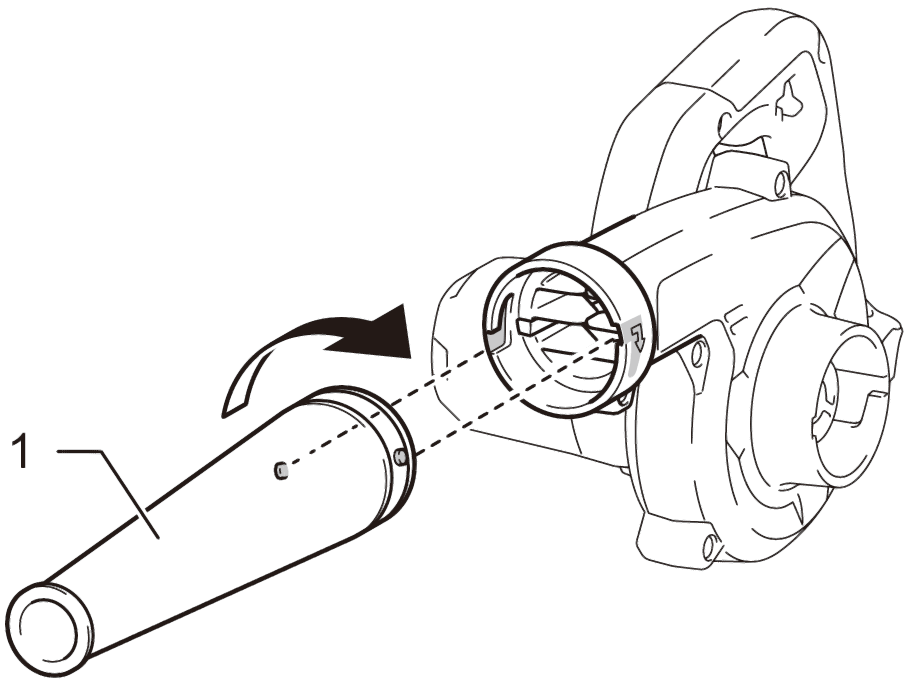

- Nozzle
To remove the nozzle, perform the installation procedure in reverse.
Installing or Removing the Garden NozzleOptional accessory for BU01Align the protrusions on the garden nozzle with the grooves on the main unit, then insert the garden nozzle into the main unit, and then turn it to lock it into place.
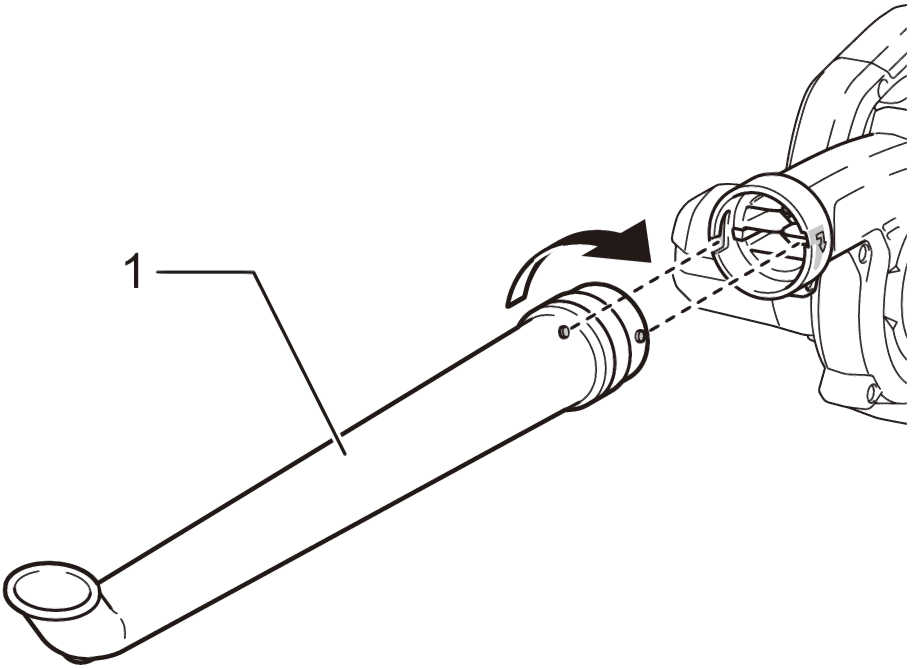

- Garden nozzle
To remove the garden nozzle, perform the installation procedure in reverse.
Installing or Removing the Brush and Wiper NozzleOptional accessory for BU01 / BU02Attach the brush nozzle or wiper nozzle to the flexible hose, and then install the flexible horse to the main unit.
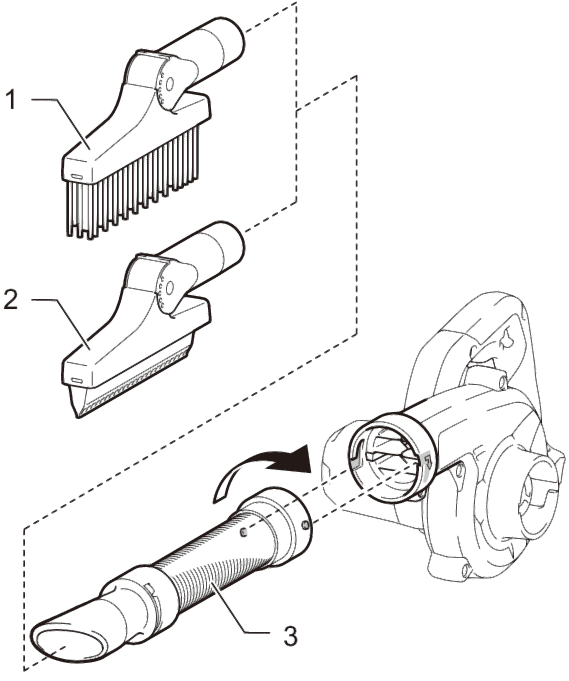

- Brush nozzle
- Wiper nozzle
- Flexible hose
To remove the brush nozzle or wiper nozzle, perform the installation procedure in reverse.
Installing or Removing the Long NozzleOptional accessory for BU01 / BU02Install the long nozzle in the same way as the nozzle. To remove the long nozzle, perform the installation proce-dure in reverse.
Installing or Removing the Tapered NozzleOptional accessory for BU01 / BU02Attach the tapered nozzle to the nozzle, and then install the nozzle to the main unit. To remove the tapered noz-zle, perform the installation procedure in reverse.
Assembly for Vacuuming
Installing or Removing the NozzleOptional accessory for BU02Align the protrusions on the nozzle with the grooves on the main unit, then insert the nozzle into the main unit, and then turn it to lock it into place.


- Nozzle
To remove the nozzle, perform the installation procedure in reverse.
Installing or Removing the Dust BagOptional accessory for BU01 / BU02Align the protrusions on the joint of dust bag with the grooves on the main unit, then insert the joint into the main unit, and then turn it to lock it into place.
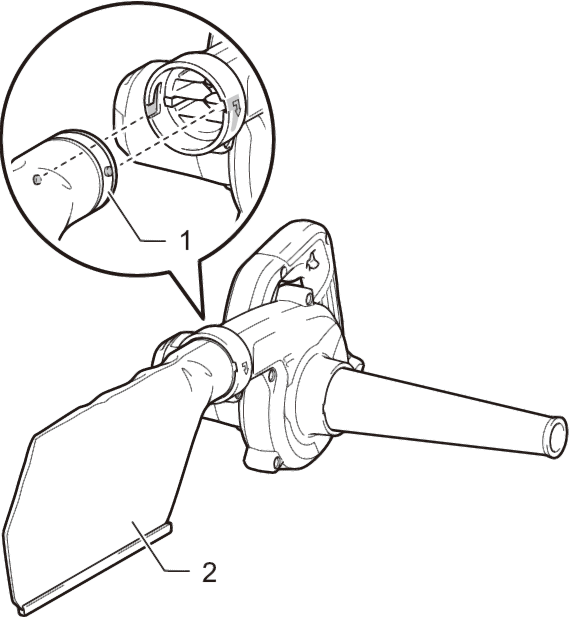

- Joint
- Dust bag
To remove the dust bag, perform the installation procedure in reverse.
Installing or Removing the Flexible Hose SetOptional accessory for BU01 / BU02Attach the joint, flexible hose, pipe, and sash nozzle to the main unit in order.
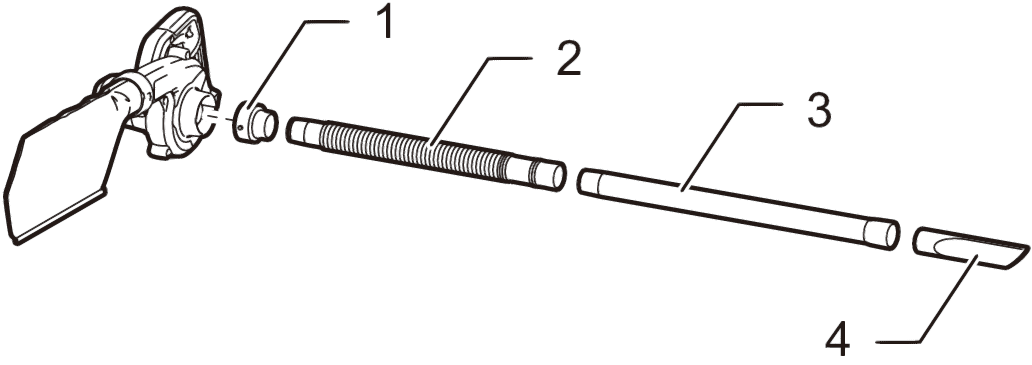

- Joint
- Flexible hose
- Pipe
- Sash nozzle
To remove the flexible hose set, perform the installation procedure in reverse.
FUNCTIONAL DESCRIPTION
Installing or Removing Battery Cartridge
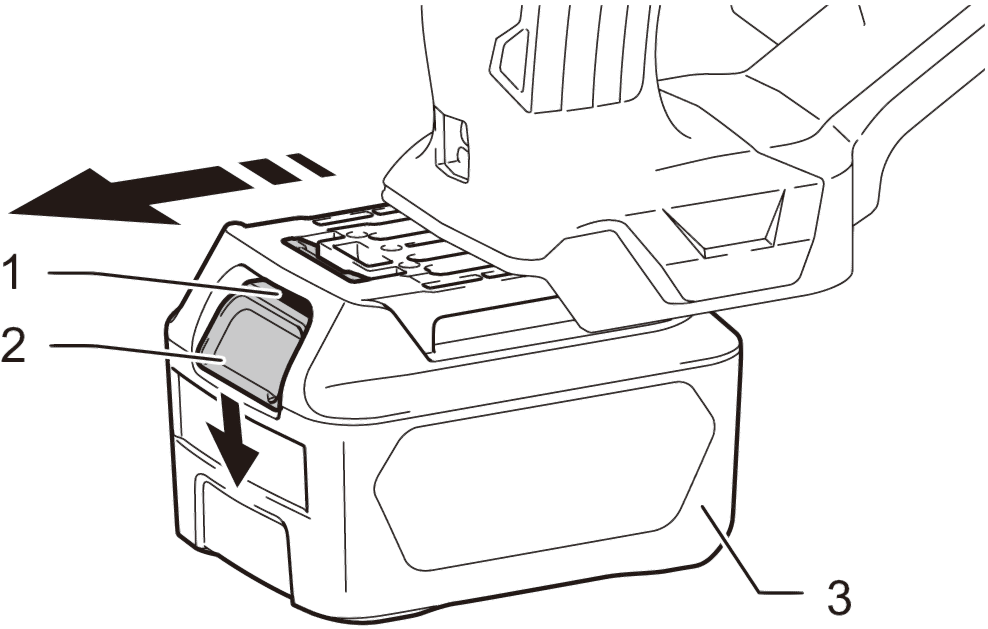

- Red indicator
- Button
- Battery cartridge
To remove the battery cartridge, slide it from the machine while sliding the button on the front of the cartridge.To install the battery cartridge, align the tongue on the battery cartridge with the groove in the housing and slip it into place. Insert it all the way until it locks in place with a little click. If you can see the red indicator on the upper side of the button, it is not locked completely.
Battery Protection System
The machine is equipped with a battery protection system. This system automatically cuts off power to the motor to extend battery life.The machine will automatically stop during operation if the machine and/or battery are placed under one of the following conditions:
Overloaded:The machine is operated in a manner that causes it to draw an abnormally high current.In this situation, turn the machine off and stop the appli-cation that caused the machine to become overloaded. Then turn the machine on to restart.If the machine does not start, the battery is overheated. In this situation, let the battery cool before turning the machine on again.
Low Battery Voltage:The remaining battery capacity is too low and the machine will not operate. If you turn the machine on, the motor runs again but stops soon. In this situation, remove and recharge the battery.
Indicating the Remaining Battery Capacity
Only for battery cartridges with the indicator
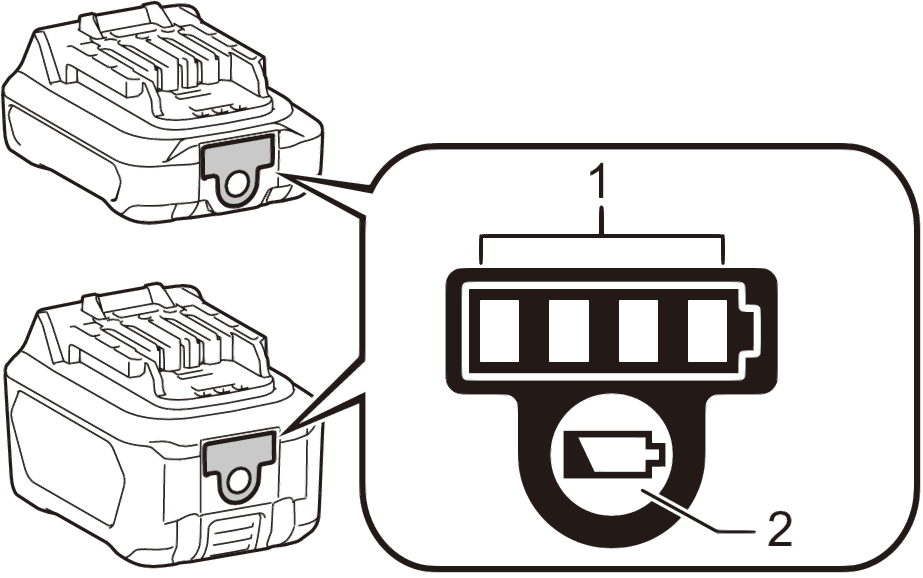

- Indicator lamps
- Check button
Press the check button on the battery cartridge to indicate the remaining battery capacity. The indicator lamps light up for a few seconds.
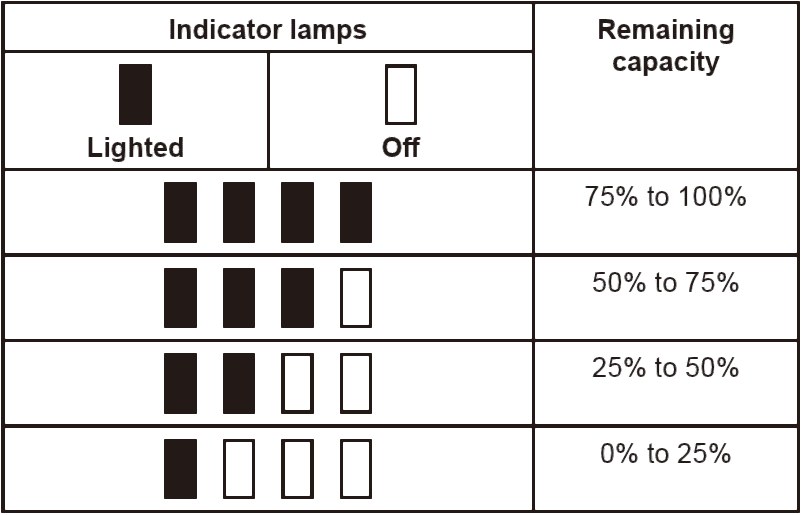

NOTE: Depending on the conditions of use and the ambient temperature, the indication may differ slightly from the actual capacity.
Switch Action
WARNING: Before installing the battery cartridge into the machine, always check to see that the switch trigger actuates properly and returns to the “OFF” position when released.
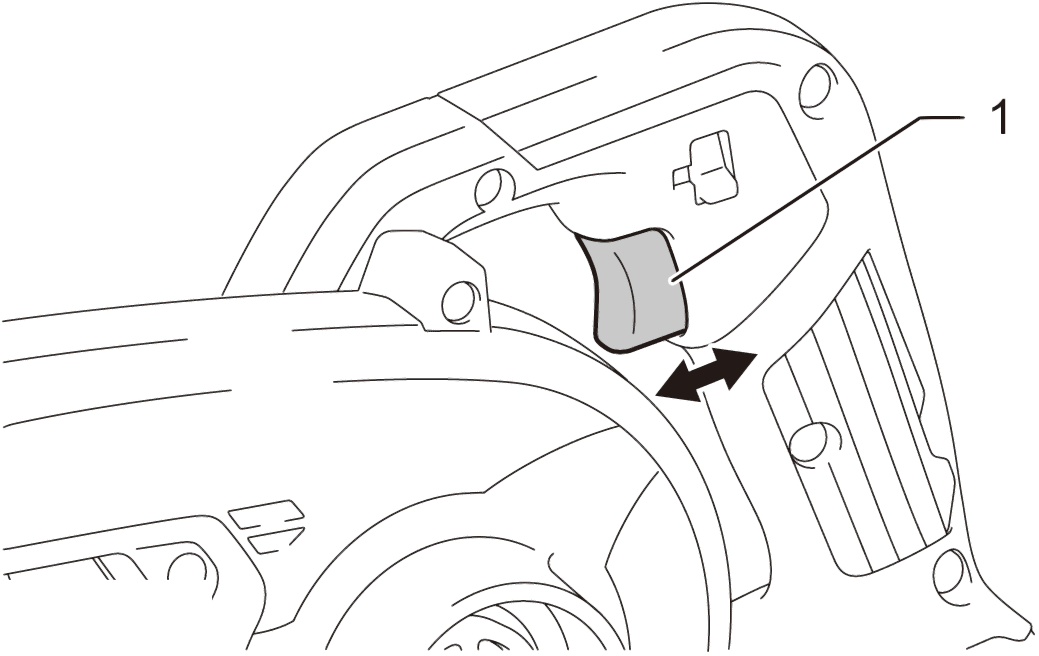

- Switch trigger
To start the machine, pull the switch trigger. The speed is increased by increasing pressure on the switch trigger. Release the switch trigger to stop.
NOTICE: If the machine has been operated continuously until the battery has become empty, rest the machine for at least 15 minutes before operating the machine with a fresh battery.
Speed Adjusting Dial
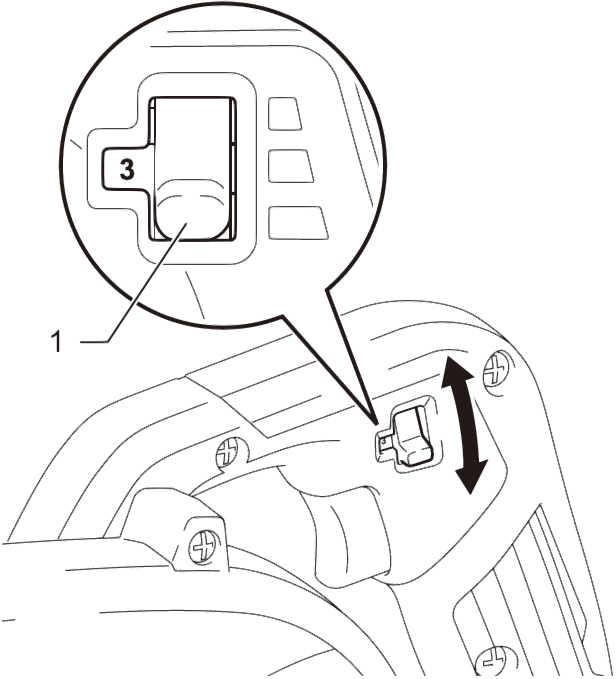

- Speed adjusting dial
The speed can be changed by turning the speed adjusting dial to a given number setting from 1 to 3. Higher speed is obtained when the dial is turned in the direction of number 3. Lower speed is obtained when it is turned in the direction of number 1.Refer to the table for the relationship between the number settings on the dial and the speed.
|
Number |
Speed |
|
3 |
High |
|
2 |
Medium |
|
1 |
Low |
NOTICE: When turning the dial, be sure to completely release the switch trigger. Otherwise, the machine may be damaged.
OPERATION
CAUTION: Do not place the machine on the ground while it is switched on. Sand or dust may enter from suction inlet and cause a malfunction or personal injury.
Blower Operation
Hold the machine firmly with a hand and perform the blowing operation by moving it around slowly. When blowing around building, big stone or vehicle, direct the nozzle away from them. When performing an operation in a corner, start from the corner and then move to wide area.For BU01
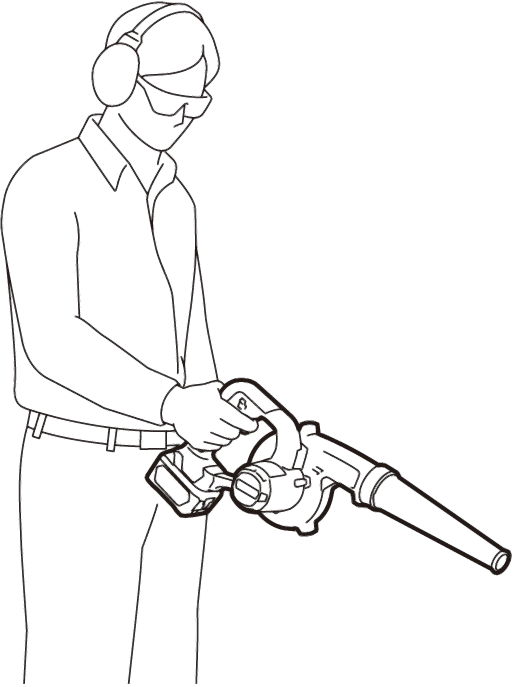

For BU02
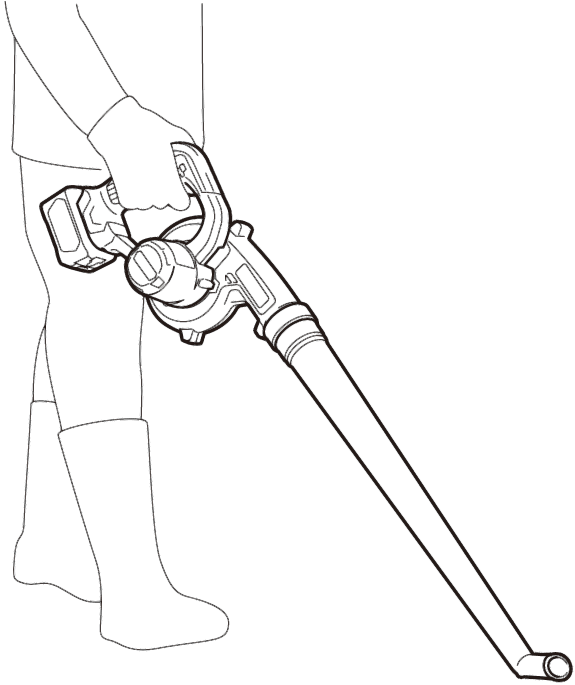

Vacuuming Operation
Hold the machine with both hands. While operating the machine, adjust the switch trigger so that the suction force is appropriate for the work location and conditions.
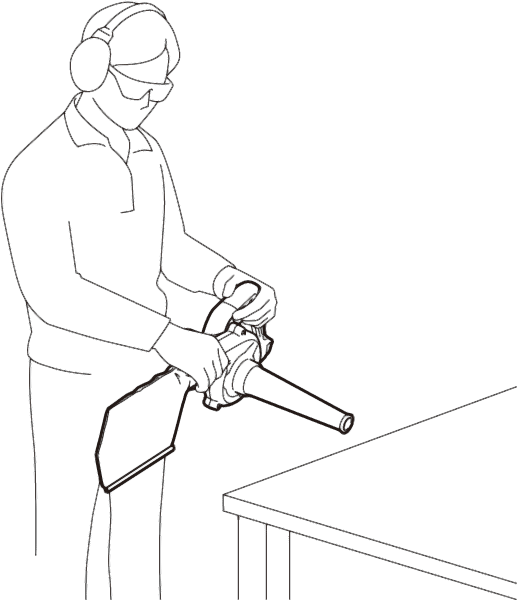

Empty the dust bag before it becomes too full by removing the dust bag from the machine, and then removing the fastener.
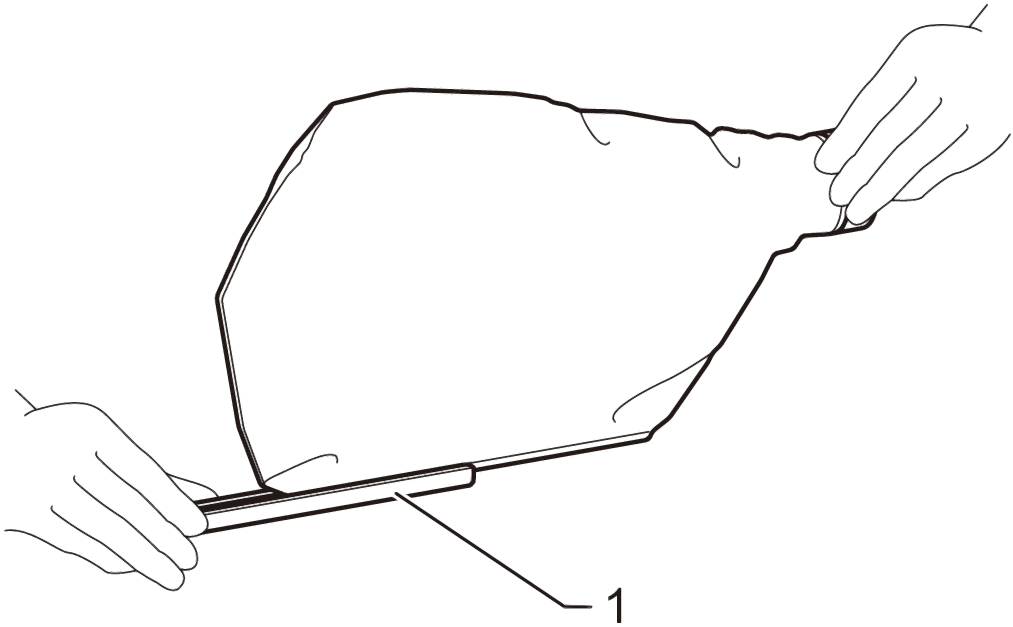

- Fastener
MAINTENANCE
To maintain product SAFETY and RELIABILITY, repairs, any other maintenance or adjustment should be performed by Makita Authorized or Factory Service Centers, always using Makita replacement parts.
Cleaning the Machine
Clean the machine by wiping off dust with a dry cloth or one dipped in soapy water and wrung out.
Remove dust or dirt from the suction inlets.
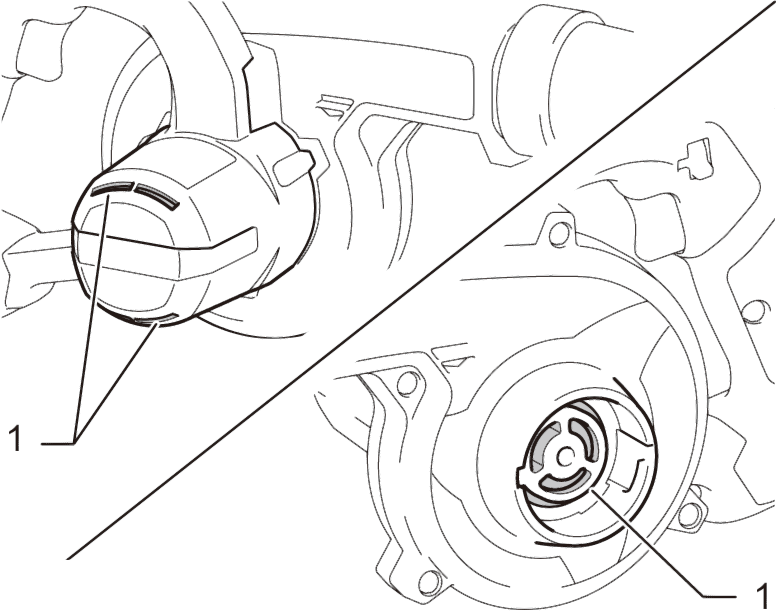

- Suction inlet
TROUBLESHOOTING
Before asking for repairs, conduct your own inspection first. If you find a problem that is not explained in the manual, do not attempt to dismantle the machine. Instead, ask Makita Authorized Service Centers, always using Makita replacement parts for repairs.
|
State of Abnormality |
Probable Cause (Malfunction) |
Remedy |
| Motor does not run. | Battery cartridge is not installed. | Install the battery cartridge. |
| Battery problem (under voltage) | Recharge the battery. If recharging is not effective,
replace battery. |
|
| The drive system does not work correctly. | Ask your local authorized service center for repair. | |
| Motor stops running after a little use. | Battery’s charge level is low. | Recharge the battery. If recharging is not effective,
replace battery. |
| Overheating. | Stop using the machine to allow it to cool down. | |
| The machine does not reach the maximum speed. | Battery is installed improperly. | Install the battery cartridge as described in this manual. |
| Battery power is dropping. | Recharge the battery. If recharging is not effective,
replace battery. |
|
| The drive system does not work correctly. | Ask your local authorized service center for repair. | |
| Abnormal vibration:
stop the machine immediately! |
The drive system does not work correctly. | Ask your local authorized service center for repair. |
| Motor cannot stop:
Remove the battery immediately! |
Electric or electronic malfunction. | Remove the battery and ask your local authorized service center for repair. |
OPTIONAL ACCESSORIES
CAUTION: These accessories or attachments are recommended for use with your Makita product specified in this manual.The use of any other accessories or attachments might present a risk of injury to persons. Only use accessory or attachment for its stated purpose.
If you need any assistance for more details regarding these accessories, ask your local Makita Service Center.
- Nozzle
- Garden nozzle
- Dust bag
- Long nozzle
- Tapered nozzle
- Flexible hose set
- Flexible hose complete (for brush/wiper nozzle)
- Brush nozzle
- Wiper nozzle
- Makita genuine battery and charger
NOTE: Some items in the list may be included in the product package as standard accessories. They may differ from country to country.
MAKITA LIMITED WARRANTY
Please refer to the annexed warranty sheet for the most current warranty terms applicable to this product. If annexed warranty sheet is not available, refer to the warranty details set forth at below website for your respective country.United States of America: www.makitatools.comCanada: www.makita.caOther Countries: www.makita.com



References
[xyz-ips snippet=”download-snippet”]

